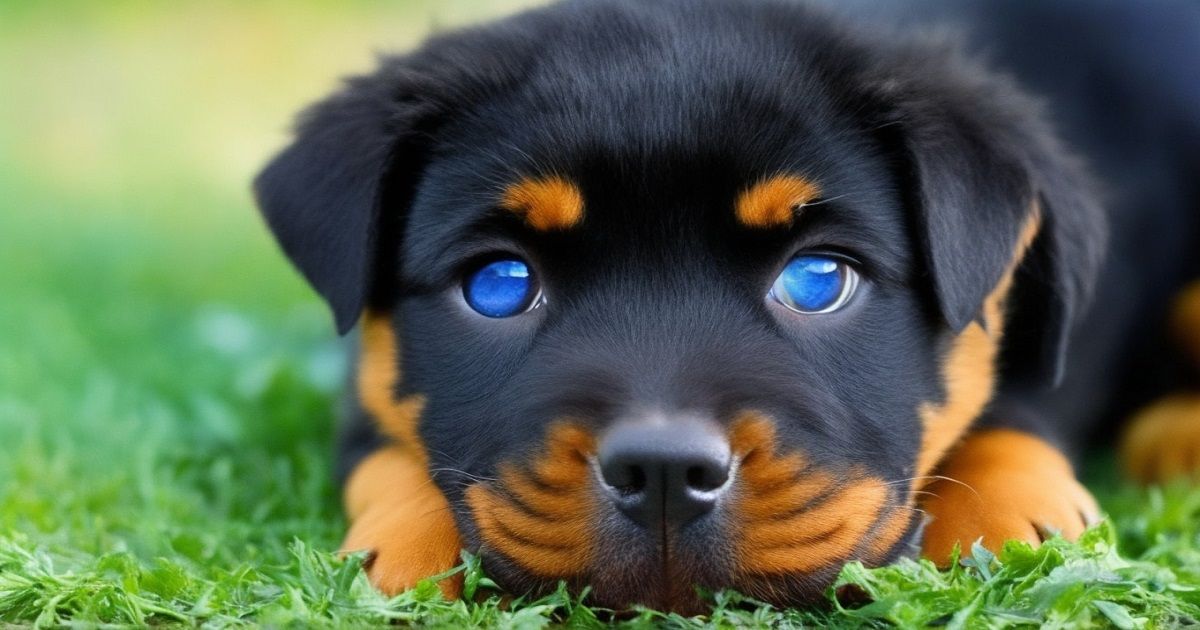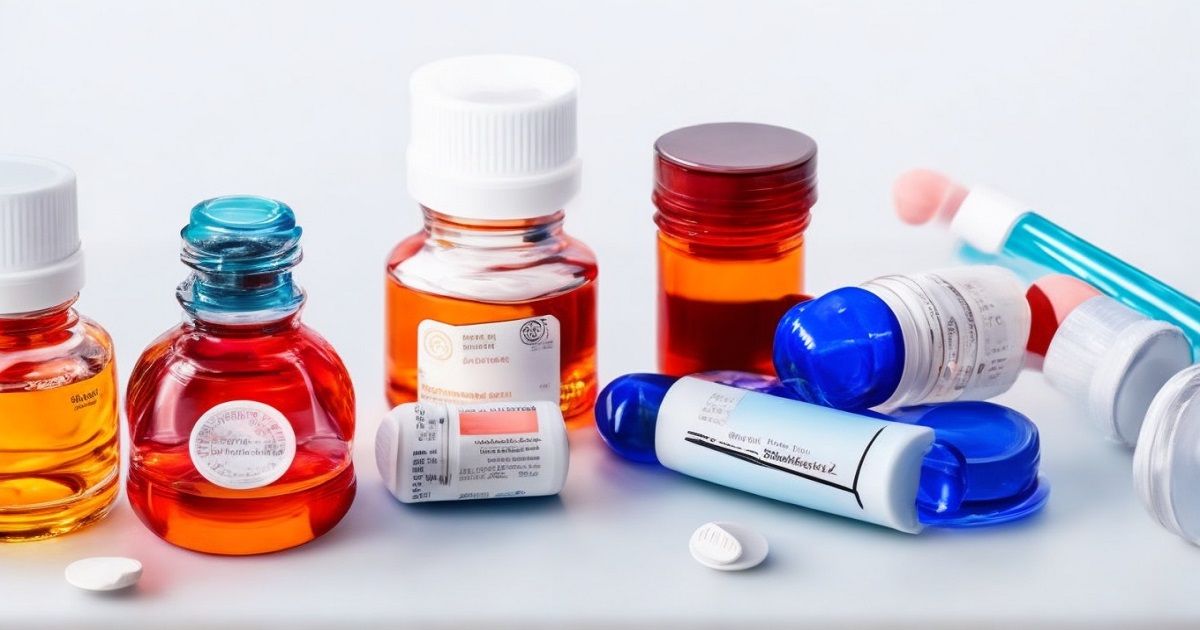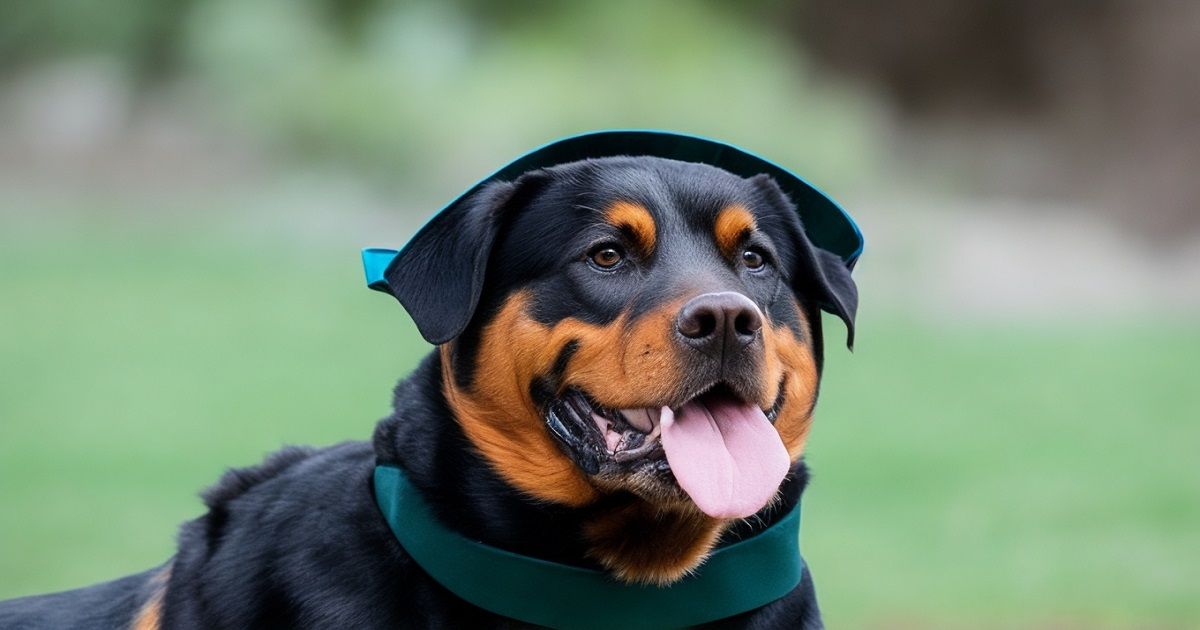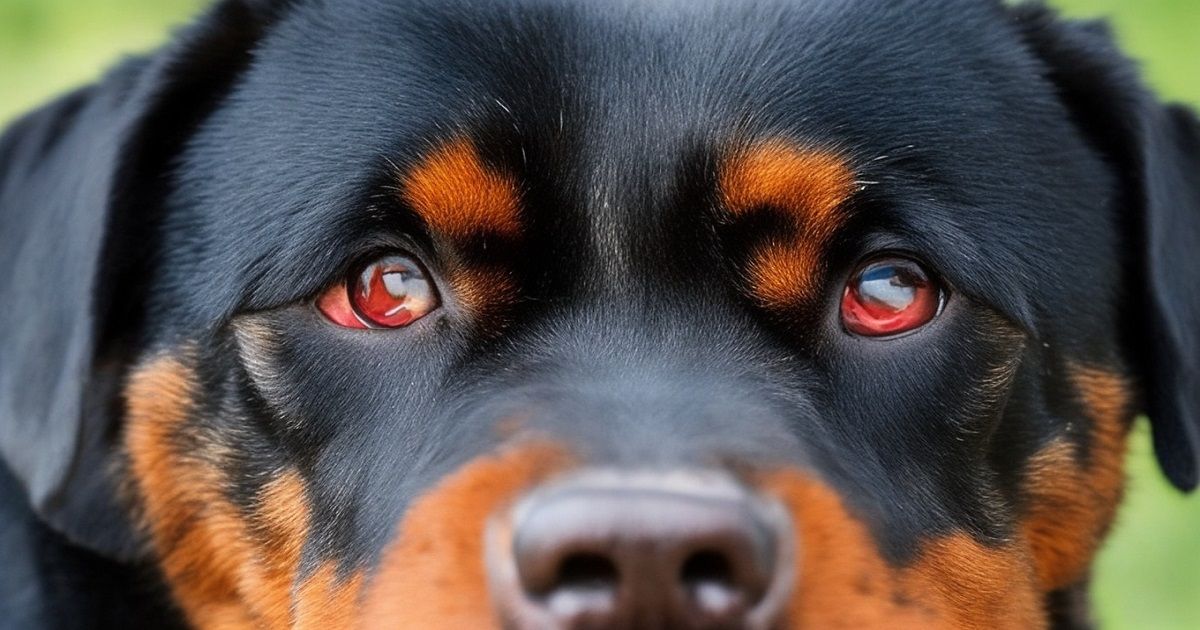Entropion is a condition in puppies in which the eyelid rolls inward, causing the eyelashes to rub against the surface of the attention. This painful condition is typically visible in Rottweilers, particularly in dogs between 4 and 12 weeks of age.
Regular inflammation due to entropion can lead to signs like excessive tearing, eye discharge, squinting, and corneal damage. If left untreated, it could cause imaginative and prescient impairment, corneal ulcers, and permanent scarring.
This text will offer an in-intensity evaluation of entropion in Rottweilers, overlaying:
- Causes – congenital defects, anatomical abnormalities, genetic predisposition
- Symptoms – eye redness, discharge, corneal ulcers
- Diagnosis – veterinary ophthalmic exams, tear exams
- Temporary treatments – ointments, eye drops
- Surgical correction – Eyelid strip elimination, tacking process.
- Aftercare – medicines, follow-up vet visits
Well-timed treatment by way of a veterinary ophthalmologist is key to dealing with entropion and stopping lengthy-term vision issues in affected Rottweilers.
Causes and Risk Factors Entropion in Rottweilers
For Rottweiler puppies, the most common cause of entropion is a congenital or inherited defect, meaning the eyelids start developing inverted right from birth. The onset of symptoms is typically between 4 and 12 weeks of age, which is when the defect becomes more apparent as the pup grows.
There are a few anatomical factors that can contribute to entropion in this breed:
- Eyelid laxity – loose, saggy eyelids that tend to droop and roll inward
- Facial structure – certain aspects like a broad skull or loose facial skin that distort the eyelid shape and position
Rottweilers also seem to have a genetic predisposition for entropion. Since it often runs in bloodlines and families, selective breeding is likely playing a role.
- For example, some breeders may intentionally or unintentionally breed dogs with a high-risk profile for entropion.
- This passes down the genetic mutation and increases prevalence within the breed.
- Likewise, not screening and excluding affected dogs from breeding programs enables the defect to perpetuate.
So in Rottweiler puppies with entropion, it’s likely a combination of hereditary traits affecting eyelid and facial anatomy, coupled with breeding practices that concentrate these genes in the population.
Now you may be wondering – why entropion crops up around 4-12 weeks specifically. Well, there are a few factors at play:
- As puppies mature and their skull takes shape, eyelid conformation can shift.
- The eyelids also become more lax with age.
- Once corneal irritation begins, it can progress rapidly if not addressed.
That’s why this 4-12-week window is so critical. Catching entropion early, before excessive corneal damage and scarring occurs, is key to protecting their vision for life.
While entropion in Rottweilers is usually congenital, older dogs can sometimes develop acquired entropion too. This results from facial muscle weakness or trauma loosening the eyelids. However, the congenital form is far more prevalent.
To sum up – a combination of hereditary eyelid factors and selective breeding perpetuates entropion in Rottweilers.
Paying attention as puppies grow through the 4-12 week phase is vital to get them the treatment they need before long-term eye problems set in.
With some adjustments to breeding practices, we can work to reduce entropion rates in this wonderful breed.
Signs and Symptoms
What to Watch Out For With Entropion in Rottweilers
Entropion in Rottweilers is a painful condition that requires quick intervention to prevent permanent damage.
But how do you know if your Rottie pup is affected? There are some clear signs and symptoms to watch out for.
The most obvious indicator is the eyelid itself rolling inward so that the eyelashes rub against the surface of the eye. You may see discharge, tearing, or squinting as well. Some other symptoms include:
- Excessive tearing – drainage of tears down the face
- Eye discharge – mucus or pus draining from the eye
- Corneal damage – clouding, ulcers, or scars on the corneal surface
- Redness and swelling – the white of the eye appears inflamed
- Squinting or blinking – The dog keeps its eyelids tightly shut to avoid pain
Dogs with entropion are trying to protect their eyes from the abrasion of inverted eyelids and eyelashes. As you can imagine, having hair constantly scratching your eyeball results in severe irritation!
Without treatment, the corneal surfaces become wounded and infected. Over time, this impairs vision and can cause total blindness.
Some entropion cases are obvious, while others are subtler. So watch for any eye redness, discharge, squinting, or watery eyes in your Rottweiler puppy.
Don’t chalk it up to allergies or normal irritation. It’s always best to have your vet take a look.
Catching entropion early is critical, before the scratching and rubbing lead to permanent corneal scarring. Then medications and minor surgery can quickly correct things before major damage occurs.
When to See the Vet
Schedule an urgent veterinary visit if you notice any of the following in your Rottweiler’s eyes:
- Rolling inward of the eyelids
- Redness, discharge, or excessive tearing
- Squinting, blinking, or keeping eyes shut
- Cloudiness or ulcers on the corneal surface
- Signs of eye pain – whimpering, pawing at their face
For young puppies, have your vet carefully examine the eyes during routine wellness visits. Entropion in Rottweilers often arises between 4 and 12 weeks of age, so include the eyes as part of comprehensive exams during this period.
Don’t delay – make that vet appointment as soon as you suspect an issue! Early intervention can help save your Rottweiler from a lifetime of impaired vision and eye problems.
Diagnosis and Testing
Confirming Entropion in Rottweilers
How do vets actually diagnose entropion in Rottweilers? There are a few standard eye tests they’ll perform to confirm the condition.
First is a routine ophthalmic exam of the entire eye, looking for:
- Inverted or rolling eyelids
- Corneal damage or ulcers
- Conjunctivitis and other signs of irritation
Other diagnostic tests may include:
- Fluorescein stain – uses eye drops to check for scratches on the cornea
- Schirmer tear test – measures tear production
- Tonometry – tests eye pressure levels
- Eye ultrasounds or CT scans – evaluate internal eye anatomy
The vet will also assess the overall eyelid structure and facial conformation. Lax or sagging lids can indicate a high risk of entropion.
For young Rottweiler puppies, the vet will likely sedate them for a very thorough eye exam to carefully inspect each surface.
Proper diagnosis of entropion in Rottweilers is key, so the vet can recommend the appropriate treatment plan based on severity.
In mild cases, medicated ointments may provide temporary relief. But most cases require surgery to permanently correct the inward rolling eyelid.
The sooner entropion is confirmed, the better! Catching it early prevents extensive damage and corneal scarring, which can permanently impact vision.
So if you notice any eye redness, irritation, or discharge in your Rottie pup, get them checked by a vet ASAP. Prompt diagnosis leads to better outcomes.
Temporary Treatment Options
Short-Term Relief for Entropion in Rottweilers
While entropion ultimately requires surgery, some temporary treatments can provide relief while preparing for the procedure.
- Lubricating ointments and eye drops – These soothe irritation and prevent the cornea from drying out when the eyelids roll inward. Ointments like artificial tears and cyclosporine help lubricate the eyes.
- Antibacterial and anti-inflammatory medications – Medications can control pain, and redness, and prevent infection while awaiting surgery. Common options are antibiotic and steroid eye drops/ointments.
- Tacking procedure – The vet may stitch a section of the eyelid outward with temporary sutures to roll it into the correct position. This offers temporary relief before permanent surgical correction.
These measures help manage the symptoms of entropion in Rottweilers and prevent corneal damage from worsening. But they aren’t long-term solutions.
When to Opt for Surgery
If corneal ulcers, cloudiness, or scarring occur, surgery is needed ASAP to prevent vision loss. Likewise, if eye redness and irritation persist despite medications.
For congenital entropion, surgery should be scheduled promptly once diagnosed, before the cornea sustains permanent injury. This offers the best prognosis for normal vision.
The key is not delayed once entropion in Rottweilers is identified. Temporary relief has its place, but surgery provides the only definitive cure.
Permanent Surgical Correction
The Definitive Cure: Surgery for Entropion in Rottweilers
The only way to fully resolve entropion in Rottweilers is through corrective eyelid surgery. This involves:
- Entropion correction surgery under anesthesia – The procedure is done under general anesthesia, usually taking 1-2 hours. The surgeon extends the eyelid so it rolls outward normally.
- Removing eyelid section to reduce laxity – Excess eyelid tissue may be removed to tighten a saggy lid, preventing inversion. This is called a wedge resection.
- Follow-up vet exams – Stitches are removed around 10-14 days post-op. The vet will check healing and monitor for any ongoing irritation or corneal issues.
Recovery and Aftercare
Proper aftercare is vital following entropion surgery in Rottweilers:
- Medications – Antibiotic and anti-inflammatory eye drops prevent infection and reduce swelling as the incision site heals.
- Elizabethan collar – The “cone of shame” prevents pawing at eyes and stabilizes the eyelids post-surgery.
- Monitor vision – Check for any corneal scarring or ongoing vision impairment, which may require further treatment.
With close monitoring and medications, most dogs heal well after entropion correction. However, the condition may return in some cases, requiring additional surgery.
Is Surgery Always Necessary?
Unfortunately, congenital entropion will almost always demand surgery in the long run. It’s considered the only reliable cure.
The key is scheduling it promptly once diagnosed to prevent permanent corneal damage. Catching entropion in Rottweilers early and surgical correction gives them the best chance of normal eye health and vision.
Prevention and Long-Term Care
While surgery treats existing entropion in Rottweilers, certain measures can help prevent it in the first place.
- Selective breeding – Screen dogs before breeding and avoid mating pairings with entropion risk. This reduces prevalence in the gene pool.
- Regular eye exams – Have your vet examine your Rottie’s eyes closely during every checkup to catch issues early. Monitor vision and eye health lifelong.
- Medicated eye drops – Use lubricating or anti-inflammatory drops as needed to maintain eye health, especially after surgery.
- See a veterinary ophthalmologist – For the best care, have a specialized eye vet evaluate entropion cases and perform the surgery.
With vigilance and early treatment, most dogs recover fully after entropion correction. But it’s ideal to prevent the issue before it starts through selective breeding and routine eye health monitoring.
For Rottweiler owners, stay alert for eye redness, discharge, or irritation in puppies. Schedule vet exams promptly at the first signs.
Catching entropion in Rottweilers quickly is key to protecting their precious eyesight and quality of life.
With proper care, you have an excellent chance of raising a happy, bright-eyed companion for years to come!
Outlook and Conclusion
In summary, entropion in Rottweilers is a common eyelid condition that requires prompt veterinary care. Inverted rolling of the lid causes corneal harm that may result in vision loss if unchecked.
Even as temporary measures like ointments and eye drops provide a few alleviations, surgical treatment is the definitive treatment for entropion.
Catching it early and scheduling correction surgery as quickly as possible gives a pleasant diagnosis.
Following your vet’s advice is critical – use any prescribed medicines diligently, attend all comply-up exams, and monitor your dog’s imagination and prescient routinely.
Accomplice intently along with your veterinary ophthalmologist for specialized eye care.
The key takeaway for Rottweiler proprietors is that: early intervention is the whole thing. At the primary signs of eye infection, redness, or discharge, have your domestic dog evaluated properly.
The 4–12-week window is particularly vital. Addressing entropion in Rottweilers promptly before corneal scarring units gives your canine the quality chance of healthy eyes and clear imaginative and prescient shifting forward.
Together with your attentive care and the right remedy technique, entropion may be cured and controlled. Don’t postpone!
Work intently together with your vet and preserve a watchful eye on the one you love Rattie’s eyes. Their bright, wholesome gaze will be lighting up your life for future years.
FAQs
What are the first signs of entropion in a Rottweiler puppy?
Look for excessive tearing, eye discharge, squinting, redness, and blinking. The eyelid itself may roll inward. These signs tend to emerge around 4-12 weeks of age.
At what age does entropion usually develop in Rottweilers?
Most cases of entropion appear between 4-12 weeks old. It is often present at birth but becomes symptomatic during this rapid growth phase.
How is entropion diagnosed by veterinarians?
Vets examine the eyes closely for inversion of the eyelids and irritation. They may use stains, tear tests, eye pressure checks, and imaging to evaluate the condition.
Is entropion painful for dogs?
Yes, entropion is very uncomfortable and painful! The constant rubbing and irritation of the cornea is severely aggravating for dogs.
How long does it take to recover from entropion surgery?
Surgical incisions heal within 2 weeks typically but medications and monitoring may continue for 1-2 months post-surgery. Most dogs recover fully within 6-8 weeks.
Will entropion correct itself without surgery?
Unfortunately no – congenital entropion requires surgery for a permanent cure. It will not resolve on its own.
What is the success rate of entropion surgery in dogs?
In most cases, entropion surgery is successful and prevents recurrence. However, some dogs may require additional surgery if it return.
How much does entropion surgery cost for dogs?
Costs range from $500-$2,000 depending on extent of correction needed. Eye specialist surgery is more expensive.
What happens if entropion is left untreated in dogs?
Untreated entropion leads to corneal scarring, eye infections, pain, and eventually blindness. Prompt surgery prevents this.
How can I prevent entropion in my Rottweiler puppy?
Selective breeding and eye exams starting at 6 weeks old can help detect entropion early before vision is impacted.










2 thoughts on “Entropion in Rottweilers: Causes, Symptoms and Treatment Options for This Painful Eyelid Condition”